New research emerging from the final orbits of NASA’s Cassini spacecraft represents a huge leap forward in our understanding of the Saturn system — especially the mysterious, never-before-explored region between the planet and its rings. Some preconceived ideas are turning out to be wrong while new questions are being raised.
Six teams of researchers are publishing their work on October 5 in the journal Science, based on findings from Cassini’s Grand Finale. That’s when, as the spacecraft was running out of fuel, the mission team steered Cassini spectacularly close to Saturn in 22 orbits before deliberately vaporizing it in a final plunge into the atmosphere in September 2017.
Knowing Cassini’s days were numbered, its mission team went for gold. The spacecraft flew where it was never designed to fly. For the first time, it probed Saturn’s magnetized environment, flew through icy, rocky ring particles, and sniffed the atmosphere in the 1,200-mile-wide (2,000-kilometer-wide) gap between the rings and the cloud tops. Not only did the flight path push the spacecraft to its limits, the new findings illustrate how powerful and agile the instruments were.
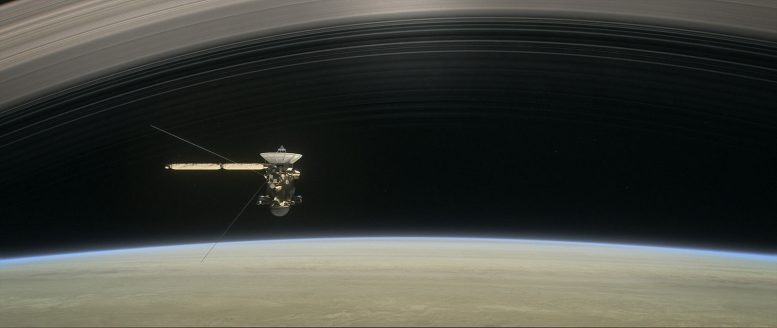
NASA’s Cassini spacecraft dives between Saturn and its innermost rings, as part of the mission’s Grand Finale. Credit: NASA/JPL-Caltech
Many more Grand Finale science results are to come, but here are some of today’s highlights:
- Complex organic compounds embedded in water nanograins rain down from Saturn’s rings into its upper atmosphere. Scientists saw water and silicates, but they were surprised to see also methane, ammonia, carbon monoxide, nitrogen, and carbon dioxide. The composition of the organics is different from that found on moon Enceladus — and also different from that on moon Titan, meaning there are at least three distinct reservoirs of organic molecules in the Saturn system.
- For the first time, Cassini saw up close how rings interact with the planet and observed inner-ring particles and gases falling directly into the atmosphere. Some particles take on electric charges and spiral along magnetic-field lines, falling into Saturn at higher latitudes — a phenomenon known as “ring rain.” But scientists were surprised to see that others are dragged quickly into Saturn at the equator. And it’s all falling out of the rings faster than scientists thought — as much as 22,000 pounds (10,000 kilograms) of material per second.
- Scientists were surprised to see what the material looks like in the gap between the rings and Saturn’s atmosphere. They knew that the particles throughout the rings ranged from large to small. But the sampling in the gap showed mostly tiny, nanometer-sized particles, like smoke, suggesting that some yet-unknown process is grinding up particles.
- Saturn and its rings are even more interconnected than scientists thought. Cassini revealed a previously unknown electric-current system that connects the rings to the top of Saturn’s atmosphere.
- Scientists discovered a new radiation belt around Saturn, close to the planet and composed of energetic particles. They found that while the belt actually intersects with the innermost ring, the ring is so tenuous that it doesn’t block the belt from forming.
- Unlike every other planet with a magnetic field in our Solar System, Saturn’s magnetic field is almost completely aligned with its spin axis. The new data shows a magnetic-field tilt of less than 0.0095 degrees. (Earth’s magnetic field is tilted 11 degrees from its spin axis.) According to everything scientists know about how planetary magnetic fields are generated, Saturn should not have one. It’s a mystery that physicists will be working to solve.
- Cassini flew above Saturn’s magnetic poles, directly sampling regions where radio emissions are generated. The findings more than doubled the number of direct measurements of radio sources from the planet, one of the few non-terrestrial locations where scientists have been able to study a radio-generation mechanism that is believed to operate throughout the universe.
For the Cassini mission, the science rolling out from Grand Finale orbits more than justifies the calculated risk of diving into the gap — skimming the upper atmosphere and skirting the edge of the inner rings, said Cassini Project Scientist Linda Spilker.
“Almost everything going on in that region turned out to be a surprise,” Spilker said. “That was the importance of going there, to explore a place we’d never been before. And the expedition really paid off — the data is tremendously exciting.”
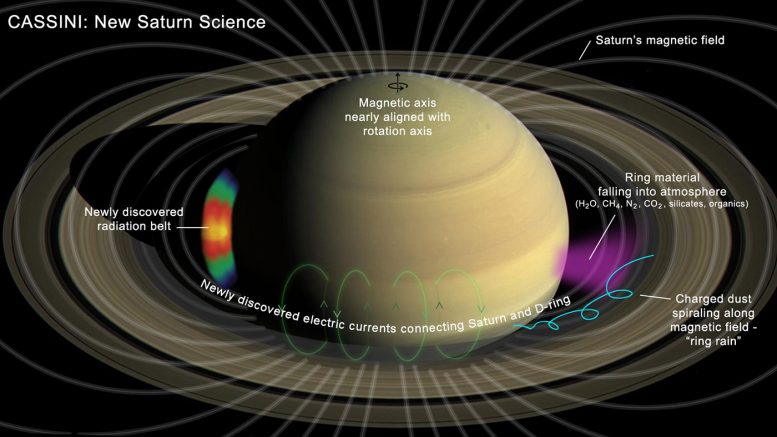
A few of the findings from Cassini’s direct sampling: complex organics rain down from Saturn’s rings; inner-ring particles take on electric charges and travel along magnetic-field lines; newly revealed electric-current system and radiation belt; and up-close measurement of Saturn’s near-zero magnetic-field tilt. Credit: NASA/JPL-Caltech
Analysis of Cassini data from the spacecraft’s instruments will be ongoing for years to come, helping to paint a clearer picture of Saturn.
“Many mysteries remain, as we put together pieces of the puzzle,” Spilker said. “Results from Cassini’s final orbits turned out to be more interesting than we could have imagined.”
The papers published in Science are:
- “Chemical interactions between Saturn’s atmosphere and its rings,” by J.Hunter Waite, et.al.
- “D-Ring dust falling into Saturn’s equatorial ionosphere and upper atmosphere,” by Donald Mitchell, et.al.
- “In-situ collection of dust grains falling from Saturn’s rings into its atmosphere,” by Hsiang-Wen Hsu, et.al.
- “A radiation belt of energetic protons located between Saturn and its rings,” by Elias Roussos, Peter Kollmann, et.al.
- “Saturn’s magnetic field revealed by the Cassini Grand Finale,” by Michele Dougherty, et.al.
- “The low frequency source of Saturn’s Kilometric Radiation (SKR),” by Laurent Lamy, et.al.
On October 4, as the Science publication embargo lifts, articles describing research complementary to these findings will post online in Geophysical Research Letters (GRL), a journal of the American Geophysical Union (AGU).
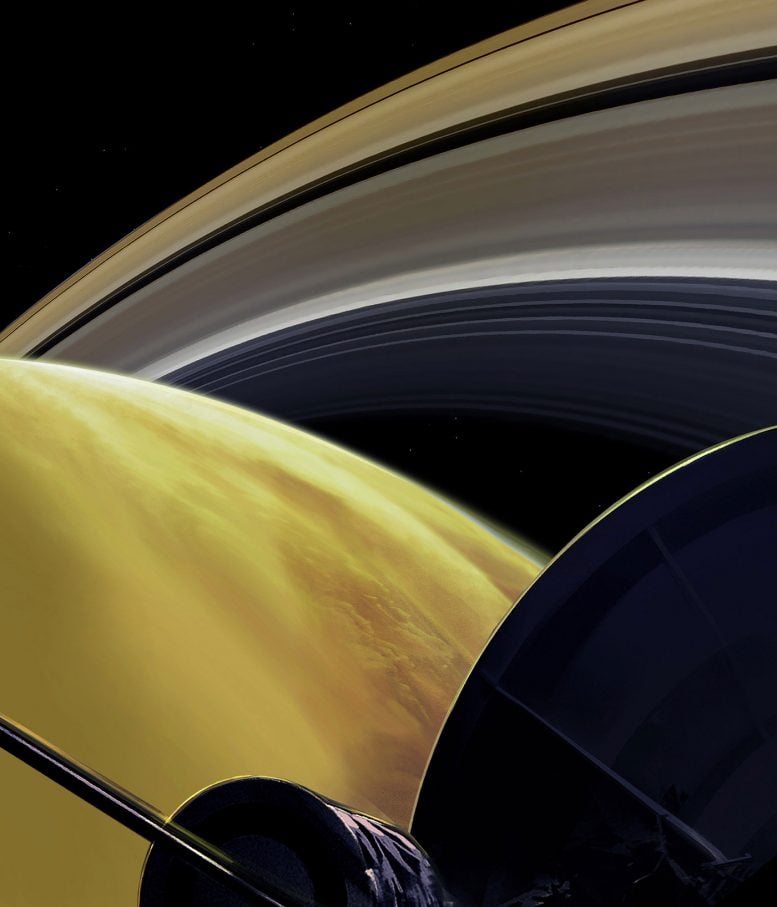
This illustration imagines the view from NASA’s Cassini spacecraft during one of its final dives between Saturn and its innermost rings, as part of the mission’s Grand Finale. Credit: NASA/JPL-Caltech
The Cassini-Huygens mission is a cooperative project of NASA, ESA (European Space Agency), and the Italian Space Agency. NASA’s Jet Propulsion Laboratory, a division of Caltech in Pasadena, manages the mission for NASA’s Science Mission Directorate in Washington. JPL designed, developed, and assembled the Cassini orbiter. The radar instrument was built by JPL and the Italian Space Agency, working with team members from the U.S. and several European countries.
References:
- “Chemical interactions between Saturn’s atmosphere and its rings” by J. H. Waite Jr., R. S. Perryman, M. E. Perry, K. E. Miller, J. Bell, T. E. Cravens, C. R. Glein, J. Grimes, M. Hedman, J. Cuzzi, T. Brockwell, B. Teolis, L. Moore, D. G. Mitchell, A. Persoon, W. S. Kurth, J.-E. Wahlund, M. Morooka, L. Z. Hadid, S. Chocron, J. Walker, A. Nagy, R. Yelle, S. Ledvina, R. Johnson, W. Tseng, O. J. Tucker and W.-H. Ip, 5 October 2018, Science.
DOI: 10.1126/science.aat2382 - “Dust grains fall from Saturn’s D-ring into its equatorial upper atmosphere” by D. G. Mitchell, M. E. Perry, D. C. Hamilton, J. H. Westlake, P. Kollmann, H. T. Smith, J. F. Carbary, J. H. Waite Jr., R. Perryman, H.-W. Hsu, J.-E. Wahlund, M. W. Morooka, L. Z. Hadid, A. M. Persoon and W. S. Kurth, 5 October 2018, Science.
DOI: 10.1126/science.aat2236 - “In situ collection of dust grains falling from Saturn’s rings into its atmosphere” by Hsiang-Wen Hsu, Jürgen Schmidt, Sascha Kempf, Frank Postberg, Georg Moragas-Klostermeyer, Martin Seis, Holger Hoffmann, Marcia Burton, Shengyi Ye, William S. Kurth, Mihály Horányi, Nozair Khawaja, Frank Spahn, Daniel Schirdewahn, James O’Donoghue, Luke Moore, Jeff Cuzzi, Geraint H. Jones and Ralf Srama, 5 October 2018, Science.
DOI: 10.1126/science.aat3185 - “A radiation belt of energetic protons located between Saturn and its rings” by E. Roussos, P. Kollmann, N. Krupp, A. Kotova, L. Regoli, C. Paranicas, D. G. Mitchell, S. M. Krimigis, D. Hamilton, P. Brandt, J. Carbary, S. Christon, K. Dialynas, I. Dandouras, M. E. Hill6, W. H. Ip, G. H. Jones, S. Livi, B. H. Mauk, B. Palmaerts, E. C. Roelof, A. Rymer, N. Sergis and H. T. Smith, 5 October 2018, Science.
DOI: 10.1126/science.aat1962 - “Saturn’s magnetic field revealed by the Cassini Grand Finale” by Michele K. Dougherty, Hao Cao, Krishan K. Khurana, Gregory J. Hunt, Gabrielle Provan, Stephen Kellock, Marcia E. Burton, Thomas A. Burk, Emma J. Bunce, Stanley W. H. Cowley, Margaret G. Kivelson, Christopher T. Russell and David J. Southwood, 5 October 2018, Science.
DOI: 10.1126/science.aat5434 - “The low-frequency source of Saturn’s kilometric radiation” by L. Lamy, P. Zarka, B. Cecconi, R. Prangé, W. S. Kurth, G. Hospodarsky, A. Persoon, M. Morooka, J.-E. Wahlund and G. J. Hunt, 5 October 2018, Science.
DOI: 10.1126/science.aat52027

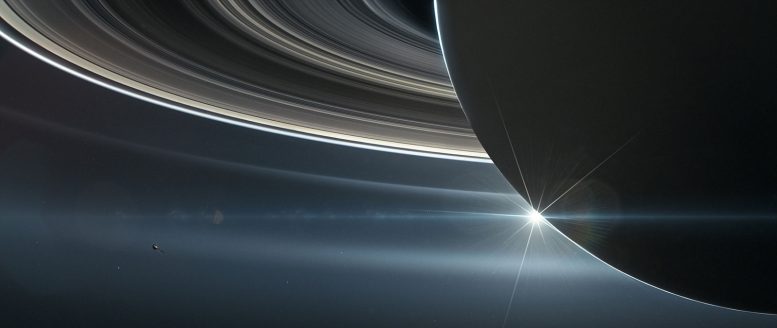
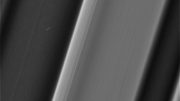
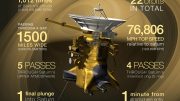
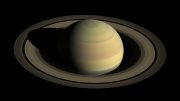
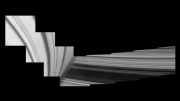
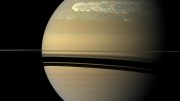
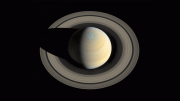
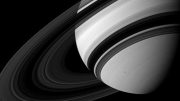

Be the first to comment on "Final Cassini Orbits Provide Huge Leap Forward in Our Understanding of the Saturn System"